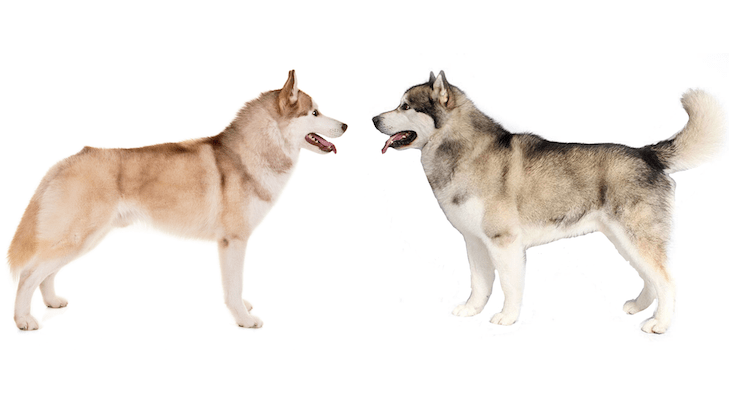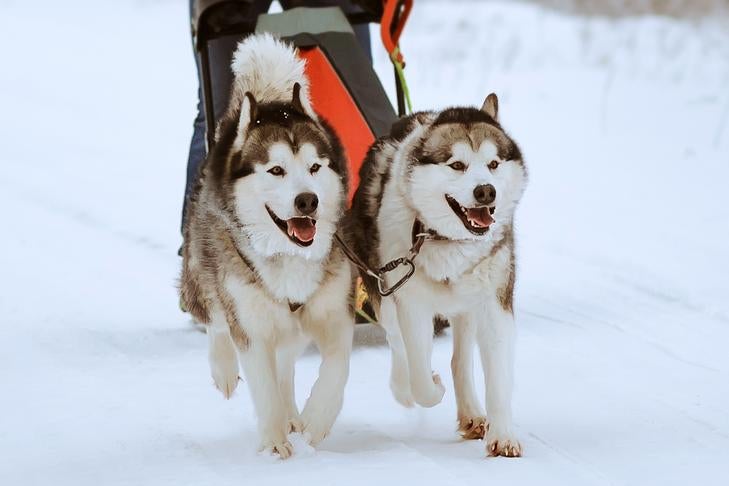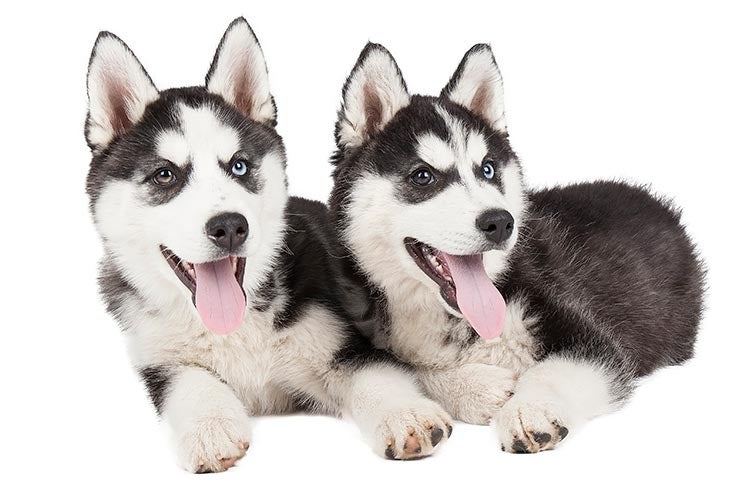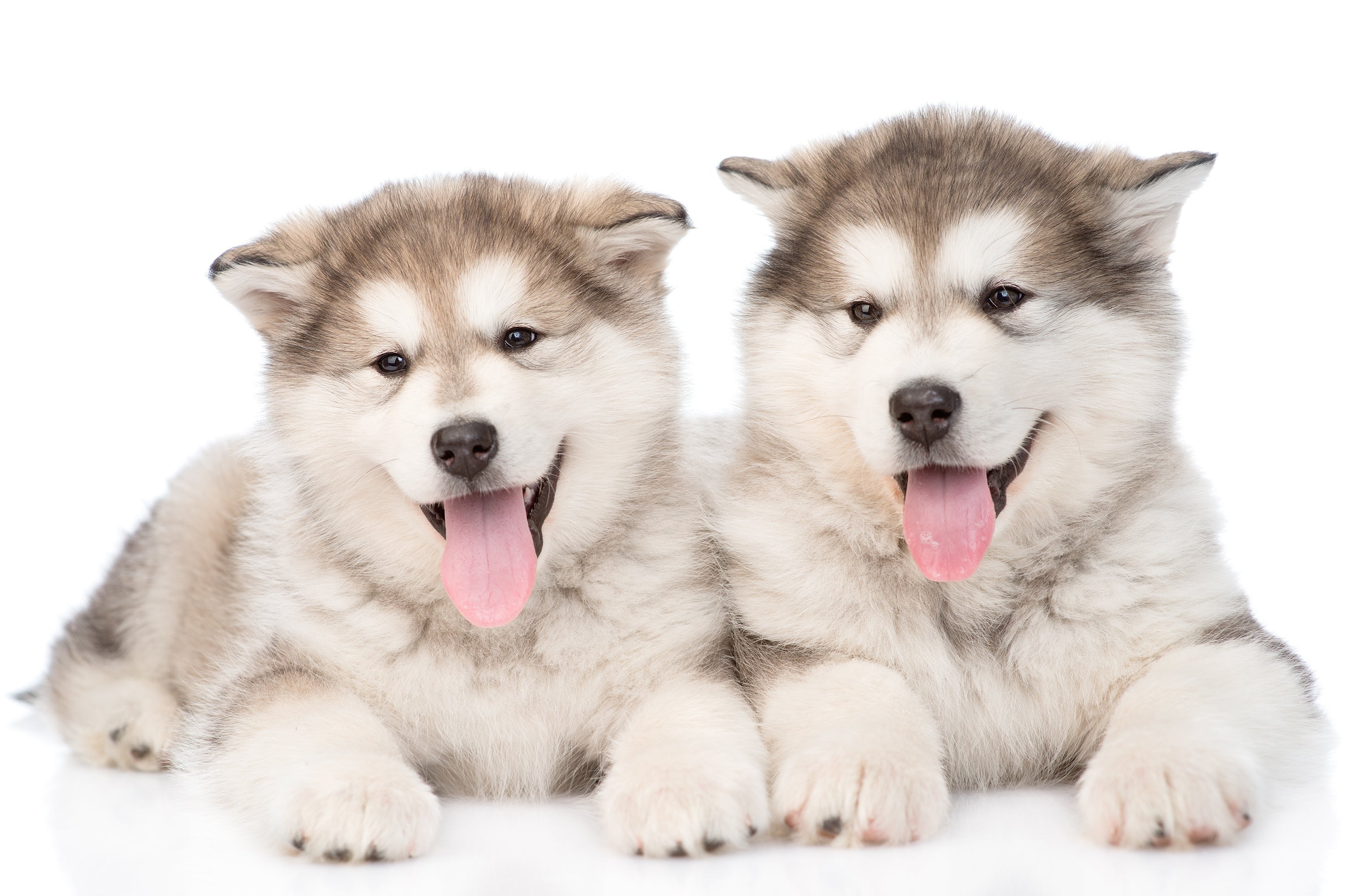
When you think of dogs pulling sleds in the Arctic, what breed comes to mind? Is it the Siberian Husky (Siberian) or the Alaskan Malamute (Mal)? Maybe you didn’t realize that, for all their similarities, these are two distinct breeds. Granted, they both originated in Arctic areas, both have thick double coats, and they both pull sleds.
According to Lenore Demmin, president of the Siberian Husky Club of America, they both even curl their thick tails over their noses when they lay down in the cold, to warm the air they’re breathing. But in fact, these two breeds have different origins, physical traits, and temperaments.
“The average person is confused about which is which,” says Demmin, who has been involved with Siberians for almost 35 years. “When they see Siberians, they are frequently surprised at how ‘small’ they are. They are amazed that they are strong enough to pull a person on a sled.”
Gena Box Young, current judges education chair for the Alaskan Malamute Club of America, agrees that those not in the know easily confuse the two breeds, and occasionally mistake them for their wild ancestors.
“Sometimes the general public even calls these breeds wolves,” admits Box Young.
- Siberian Husky in the conformation ring.
- Alaskan Malamute in the conformation ring.
History in Harsh Climates
Both breeds originated in climates of extreme and unforgiving cold, but one hails from northern Asia and the other from closer to home. The key is in the name. The Siberian Husky, who ranks 14th among AKC recognized breeds in popularity, comes from Siberia. The Alaskan Malamute, which ranks 58th, originated in Alaska.
“They were bred by the native peoples of Siberia as a mode of transportation to follow the scarce food sources,” explains Demmin of the Siberian’s origins in harsh climates. “The Siberian Husky was required to go day after day on very little food. Every aspect of the Siberian Husky is exceptionally efficient. No excess or waste.”
The Mal, on the other hand, was essential to the survival of a different people: the Mahlemut tribe. Like Siberians, these dogs worked hard in the brutal climates, often on starvation diets. They lived with the Mahlemut as part of the family but hunted, carried packs, and pulled sleds as well.
Ultimately, the breed was almost lost during Alaska’s gold rush due to the need for working dogs. To meet the demand, people bred outside breeds with the native dogs. Thankfully, the dogs of the Mahlemut tribe saved the day.
“Due to the remote area where the Mahlemut tribe lived, their lines remained relatively pure. They were the foundation for the Alaskan Malamute,” says Box Young, who is also an AKC judge and long-time exhibitor and breeder.
Both Built for Sledding
Thanks to their existence enduring harsh, cold climates, both breeds share certain characteristics, such as plenty of fur between their toes. And since both pull sleds, they share smooth, efficient, and effortless movements. However, close examination reveals more differences than similarities.
“The Siberian coat is the same length over the entire body, somewhat smooth lying and never harsh. But the Mal coat is longer ‘over the shoulders and neck, down the back, over the rump, and in the breeching and plume’ and has a coarse texture,” describes Box Young.
- Siberian Husky sled dogs
In addition, there are differences in the head. The Mal’s muzzle is bulky whereas the Siberian’s is of medium width. And the Siberian has high set ears that point straight up. However, the ears of the Mal should point slightly forward. High set ears are considered a fault in the conformation ring. Finally, the Siberian is allowed to have those recognizable piercing blue eyes, but those would be a disqualifying fault in a Mal. According to Demmin, the purpose for which each breed was developed led to the main physical differences.
“The Siberian Husky was bred to pull light loads over long distances,” says Demmin. “The Alaskan Malamute was bred to pull heavy loads over short distances. I like to compare the Siberian to a marathon runner – light and nimble. The Malamute is the weightlifter – big and strong.”
This is evident in the weight of each breed. The Siberian Husky breed standard states that females weigh 35 to 50 pounds and males 45 to 60 pounds. In contrast, the Alaskan Malamute breed standard describes desirable freighting size: 75 pounds for the female and 85 pounds for the male.
A Shared Love of Running
The goal of nearly every Siberian is to run, and some are on a never-ending quest to get out and pursue their favorite pastime.
“When a gate is not locked shut, they will figure out how to open the latch and escape,” cautions Demmin. “If the gate is locked, they will try to go over it. When they can’t go over, they will try digging under. Running is what they were bred for and is the thing they love to do most.”
In other words, a Siberian sees a locked gate as just another test to conquer. This creative and intelligent approach to life makes them a challenge for first-time dog owners. If you own one, you will be constantly trying to outwit your dog. But it’s well worth the work, as they are not only beautiful but very friendly. Rather than attaching to only one person, they love their whole family and are not at all protective.
“They may look like a good guard dog, but the only thing they really love to guard is food and toys,” says Demmin. “Not you or your property.”
Mals tend to share the Siberian love of running, but without the same risk of escape.
“I have been told that if you let both breeds out of the house to run around in the yard, after a little while the Mals will come to the back door to get back into the house to be with their people and the Siberians will still be looking for a way to get out of the yard,” says Box Young.
Which Breed is Better For You?
- Siberian Husky puppies
- Alaskan Malamute puppies
Like the Siberians, Mals are affectionate and friendly dogs. Along with running, they love to be with their people and to eat. This means these relatively obedient dogs are most motivated when food is involved. Usually quiet, many Mals sing a “woo woo” sound, when it’s time to eat, run, or play. Adults are fairly calm and will happily lay with you while you relax. But they are just as keen to be active with you.
According to Box Young, they are not a one-person dog, but rather love all of their people. However, she does suggest exercising caution around other dogs.
“As much as they love people, they are not always so good with other dogs of the same sex,” says Box Young. “I usually advise puppy buyers who have a dog already to get a Malamute of the opposite sex.”
Whether it’s the powerful Mal or the creative Siberian, these are two breeds of exceptional beauty and athleticism. Both are defined by their original purpose as sled dogs of the harsh north. However, these dogs are happy to settle into more comfortable climates with their families. If you love exercise and want to see the outdoors through the eyes of an Arctic breed, consider welcoming one of these dogs into your home. Visit the AKC Marketplace to browse available Siberian Husky and Alaskan Malamute puppies from reputable breeders.







